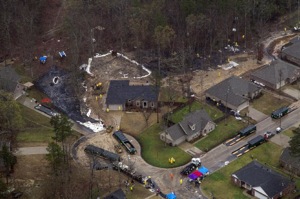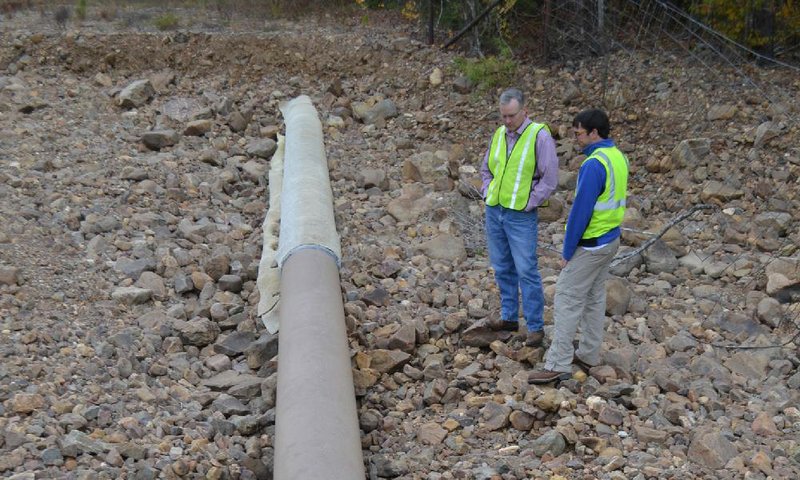Exxon Mobil has no plans to abandon the segment of its aging Pegasus pipeline that runs through the Lake Maumelle watershed, and intends to do repairs on that section, according to a Central Arkansas Water spokesman and documents obtained Wednesday.

The 850-mile-long pipeline has been closed since a rupture in a Mayflower neighborhood March 29 spilled an estimated 210,000 gallons of thick crude oil. That cleanup continues.
A Texas laboratory hired by Exxon Mobil determined that manufacturing defects, specifically cracks, were in part to blame for the spill. The laboratory said the cracks likely occurred shortly after the pipe’s manufacture in 1947-48 and worsened over time.
The utility and several Arkansas politicians have repeatedly urged Exxon Mobil Corp.’s pipeline subsidiaries to relocate the line from the watershed, which provides drinking water to about 400,000 central Arkansans.
Notes taken by utility spokesman John Tynan and Robert Hart, the utility’s technical services officer, during a Nov. 26 conference call with Exxon Mobil representatives reflect their answers to questions about the future of the pipeline, which runs from Patoka, Ill., to the Texas Gulf Coast.
Tynan said in an interview Wednesday that he wasn’t certain whether the Exxon Mobil representatives meant that the company has no plans to retire the entire line, but noted it was clear that the company does not plan at this time to abandon or retire the watershed segment, though all options remain “on the table.”
Handwritten notes taken by Hart and obtained along with other documents under the Arkansas Freedom of Information Act show that Hart at one point wrote, “No plans for abandonment. … Intend to keep everyone in the loop. Will share the Restart Plan and Remedial Work Plan.”
Tynan’s notes, likewise, say, “All options on table, but presently no plans in place or process for abandonment.”
In August, Karen Tyrone, an Exxon Mobil Pipeline Co. vice president, said retirement of the entire line was “within the realm of possibilities.”
Another clue that Exxon Mobil at least hopes to reopen the Pegasus, including the part that runs through the watershed, appears in the company’s references to repair work and improvements planned in that area.
One of the pipe segments that Tynan said the company now plans to place back beneath the ground is a large, exposed section patched up several months ago with a material that protects the metal from rocks. Exxon Mobil used Duct tape to attach that material, which resembles insulation but has a more “rubbery texture,” Tynan said.
Since then, the tape has begun “hanging loose,” and even more of the pipe has become exposed, according to officials who have seen it recently - including U.S. Rep. Tim Griffin, R-Ark., who visited the site in November.
“The fact that Exxon taped [the material to the pipe] in an incomplete and unacceptable fashion is evidence that they know there’s a potential danger there,” Griffin said Wednesday. “They recognize the danger, but they have failed to address it properly as evidenced by significant portions of the pipe being exposed and … the sloppy work being done and … to at least attempt to protect it.”
But Griffin added, “I don’t care what they do to fix that. I’ve already made it clear that I’m against them restarting [the pipeline] regardless. … This is a discussion of whether they have historically met their obligation. … What they need to do,” he said, is to get rid of the old pipeline, replace it with new pipe and be certain a new line does not run through the watershed.
Tynan said that segment, which is 60-70 feet long, is just one of the pipeline sections that were intended to be buried but are now exposed. The utility is especially concerned about that segment because of large rocks that could strike and damage the pipe when water flows through the rugged creek bed where it sits after a heavy rain.
“This is a section that we’ve mentioned to Exxon a number of times in the past,” Tynan said. “It’s been in the present state since early spring at least.”
Tynan’s notes from the Nov. 26 conference call refer to the section of the now-exposed pipeline and say, “Repairs in past [have] been rock [illegible] & rock shield,” but add, “pipe burial is new approach” and add, “[burying] pipe in same place.”
In the interview, Tynan said Exxon Mobil representatives “have indicated they are working toward moving forward with burying some of the exposed sections.” He said the company needs permits before it can begin.
When asked why Exxon Mobil relied only on the protective material and Duct tape to deal with the exposed pipe, spokesman Aaron Stryk did not answer. Rather, he said in an email, “Exxon Mobil officials did not engage in discussions about the use of duct tape as an approved measure of pipe protection in the watershed. This is simply false.”
Stryk also did not address a question seeking clarification on what was meant by no current plans and no process to abandon the pipeline.
Rather, he said, “It is premature to speculate on next steps until the [oil-spill] investigation is complete.” Exxon Mobil is committed “to transparency and integrity,” he added.
Despite exposed pipe in the watershed, Exxon Mobil representatives told Hart and Tynan on Nov. 26 that the company treats the entire pipeline as a high-consequence area, or HCA, according to the utility officials’ notes.
Tynan, for example, wrote: “[Therefore,] no diff treatment for watershed [because] ‘took highest standard for all of Pegasus.’” His notes later, however, reflect that Exxon Mobil also said its activities in the watershed go beyond requirements for high-consequence areas.
In the interview, Tynan explained, “Exxon indicated there are things they may do in the watershed or other areas that go beyond HCA requirements,” and the “implication” was that they don’t do those things in other areas - “for example, working with us to develop the tactical response plan” in the event of a pipeline spill in the watershed.
Asked to clarify, Stryk said, “We treat the entire area of the Pegasus pipeline as a high consequence area. We use the highest regulatory standard for development of our integrity management plans, emergency response preparedness, etc.
“That does not mean [we] won’t do more for sensitive areas such as the Maumelle watershed. For example, over the past two years, and in collaboration with CAW [Central Arkansas Water], [Exxon Mobil Pipeline Co.] developed a tactical response plan to address emergency response concerns over the Maumelle watershed, including more than 250 pages of detailed scenarios and tactics for how to respond to an incident.
“Tactical spill plans are not required by regulation,” Stryk added. “The one for Lake Maumelle came out of our discussions with the [Central Arkansas Water] on how best to protect the lake. The idea for the plan was proposed by Exxon Mobil and we reviewed the plan with the CAW before it was completed in late 2011/ early 2012.”
Damon Hill, a spokesman for the federal Pipeline and Hazardous Materials Safety Administration, said in an email that some pipeline “operators do treat their systems as if the entire line lies within [a high consequence area], but that doesn’t mean that the operator has identified [high consequence areas] along the entire length of the system.”
The safety administration has proposed that Exxon Mobil be fined a total of more than $2.6 million for nine alleged safety violations. Exxon Mobil has not said whether it will challenge the allegations, and Hill said the company had not submitted a response as of Wednesday.
The company has 30 days from Nov. 6 to respond if it intends to challenge the proposed violations and proposed fine.
Tynan also said Exxon Mobil still has not provided some information that the utility has requested but has agreed to share more soon. Among unanswered questions is how much crude oil could be leaked if there’s a rupture within the Lake Maumelle watershed.
Front Section, Pages 1 on 12/05/2013

